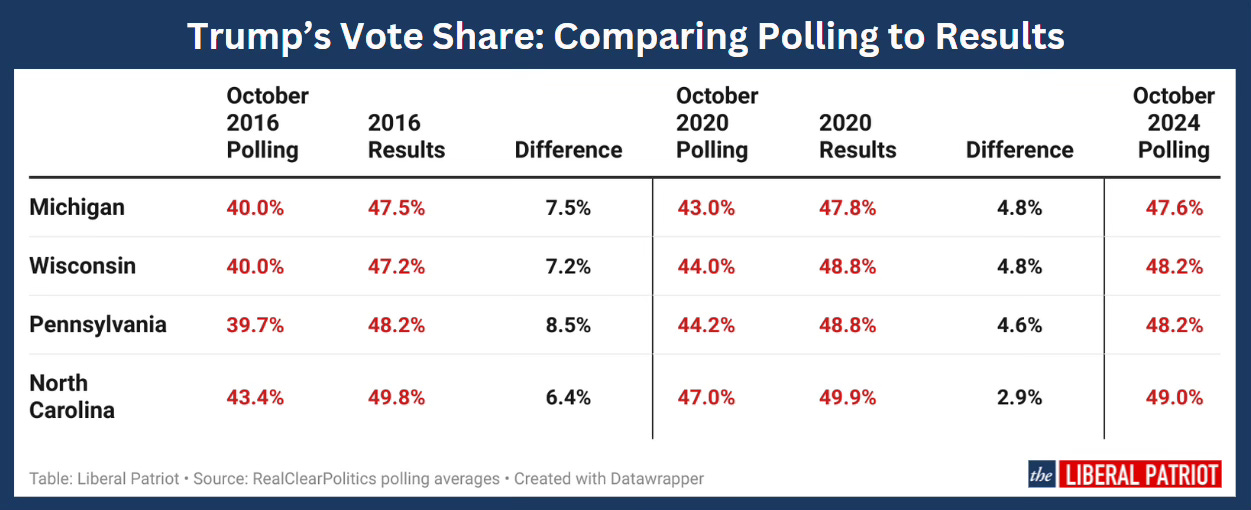Look at Vote Share, Not Margin, for November Clues
Could Rust Belt polling finally be accurate this year?
Eight years ago this week, Donald Trump was reeling from the public release of the Access Hollywood tape. Hillary Clinton expanded her advantage in polls and many saw the outcome of the presidential race as a foregone conclusion. Her six- to eight-point lead across the Midwestern battlegrounds appeared insurmountable. This sole focus on margin, rather than vote share was—and continues to be—a mistake.
Had pundits looked only at Clinton’s vote share in early October 2016, I imagine they might have come to a very different conclusion about her chances: she was stuck around 46 percent in most battlegrounds with more than ten percent of the electorate remaining undecided. Though certainly unlikely, there was a path for Trump to sneak past her if he overwhelmingly won late deciders—and, infamously, that’s exactly what he did.
As the tables above show, the 2016 polls actually predicted Clinton’s vote share with remarkable accuracy. Across Michigan, Wisconsin, Pennsylvania, and North Carolina, the polling average one month before Election Day missed her final vote share by an average of less than one point. That’s pretty darn good!
The polling disaster, of course, came from wildly underestimating Trump’s vote share. Across the four states, early October polling averages undershot his eventual total by an average of 7.5 points.
This split reappeared in 2020. Yet again, October polls understated Trump’s support, albeit to a lesser extent than 2016. But the polls did zero in on Biden’s share—missing his eventual total by just a couple points in Michigan and by a point or less in Wisconsin, Pennsylvania, and North Carolina.
Amidst the poll trashing of the last decade, this is a surprising conclusion that bears repeating: state-level polling averages in the “Blue Wall” actually nailed Democratic vote shares in 2016 and 2020. Given this accuracy, I’d argue that Harris’s vote share, much more than any margin, is the number to watch over the next month. A Michigan poll where she leads, say, 51 percent to 48 percent might actually be better news for Democrats than one where she leads 47 percent to 41 percent—despite a meaningfully better margin in the latter.
And what about Trump? His vote share in “Blue Wall” polls today is significantly higher than at any point in his past two presidential bids. He is about eight points higher than his October 2016 numbers and four points higher than his October 2020 numbers. This is good news for Team Trump—it is surely better to have higher poll numbers than lower! But the higher vote share also cuts against the preferred Trumpian argument that polls will dramatically underestimate his Midwestern support for a third cycle in a row.
The former president has a firm vote-share ceiling. In neither 2016 nor 2020 did Trump crack 48 percent in Michigan, 49 percent in Wisconsin or Pennsylvania, or 50 percent in North Carolina. So it is no surprise that Trump’s current polling places him around 47 percent in Michigan, 48 percent in Pennsylvania and Wisconsin, and 49 percent in North Carolina—all a point shy of that ceiling. There simply isn’t much room for Trump to significantly overperform current polling this year: he’s starting much closer to his ceiling, not to mention the share of undecided voters is at a historic low.
That is not to say Harris will win. All Trump needs is an error of a point or two and he’s back in the White House. That sort of polling error happens all the time. But given where vote shares stand today, a 2016-esque (or even 2020-esque) underestimation of Trump’s support appears unlikely.
Perhaps Trump smashes through his ceiling or the polls misread Democratic support this time around. But regardless of opinions on predicted polling accuracy, vote share—not margin—is a much better number to watch as the clock ticks down to November 5.






Ok, Ruy, this is one I disagree with you on. I distinctly remember one pollster had Clinton +11 in WI (!!!) and the average was a miss of 6 points; I was in OH at the time and every single pollster except Baris and Trafalgar had Trump around +4 in OH (was +8.5 in 16). In 20, again, the pollsters averaged Trump +4 in OH (one had him losing by 4!) and again he was +8. So perhaps it's whatever potpourri of pollsters you choose. I would immediately boot Quinnipiac, TIPP, NBC, yougov, Fox, and Economist. The only ones in this cycle reasonably close are Insider Advantage, Democracy Institute, Atlas, Baris/Big Data, and Trafalgar.
You are quite right that Trump overperforms on average at least 2.1. BUT . . .
This cycle even THAT misses that massive, and I mean massive voter registration changes. I've talked about AZ before---last night Maricopa Co. alone went over 174,000 R advantage. Game over here. But the movement is shocking in PA, where Rs have out registered Ds by almost 40,000 in the last month alone. New Hampshire (yes, NH) has gotten so close that my colleague Seth Keshel ("Captain K's Corner on substack) Now has it a tie.
Finally---and I know people hate to hear this---I don't believe ANY 2020 stats are trustworthy. Simply no 81 million votes. So it's a corrupted data file. We'll see, but I hear other rumblings that Harris has pulled all ads from NV. If true, she's already given up there.